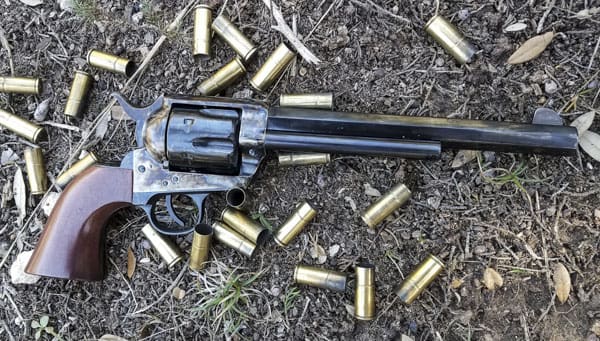
I’ve loved westerns for as long was I can remember. Since my belt had “Duke” embossed on the back of it when I was four years old, I don’t think I had much choice. But it wasn’t the movies that made me want to shoot a single action revolver or made me dream of the quick draw. It was real life.
I got to see a quick draw shooting demonstration by Bob Munden when I was young enough to be enamored, but old enough to assume it was a trick. It wasn’t a trick. There are five speeds to good shooting; fast, real fast, Jerry Michulek, light speed and Bob Munden. No matter how good your favorite shooter on YouTube is, they aren’t Munden fast. Mr. Muden was most famous for being able to draw and fire — accurately — faster than the blink of an eye. That’s not hyperbole. He could do it literally faster than a human being can blink.
As much as I’ve practiced with my Ruger Blackhawk, it turns out that I have absolutely no talent for that kind of shooting. There’s not a bit of fast anywhere in me, and I couldn’t hit the broadside of a barn without looking right down the sights. But man was it fun, and I never lost my love of the single action revolver.
I’m hardly alone in my affection for the genre. Specialty gunmakers are churning out great-looking quality pistols for the single action enthusiast. Many, if not most of these are based on the 1873 Colt Single Action Army Model P.
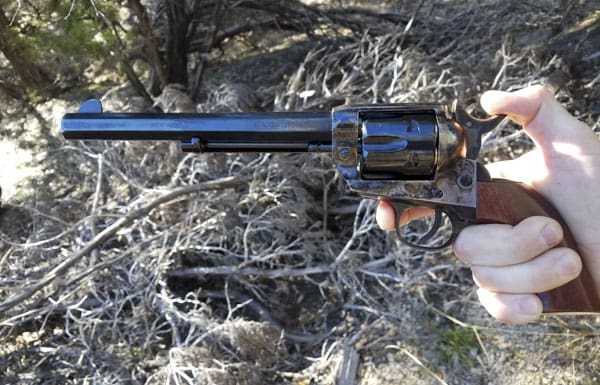
The Peacemaker, as it was called, is probably the most recognized of the old west firearms. You can find modern examples of every version and custom one-off made. Really, there’s something for everyone. This customization usually means a high price, especially for a firearm that’s likely limited to range duty or the occasional hunting trip.
Enter Cimarron Firearms. The Fredericksburg, Texas firearm company offers the SA enthusiast a less expensive recreation of the 1873 Single Action Army — a great looking one-off version of the Peacemaker bound to tickle the fancy of the cowboy and wild west enthusiast. Cimarron calls it the El Malo. The Bad One.

The El Malo is a good looking gun right out of the box.
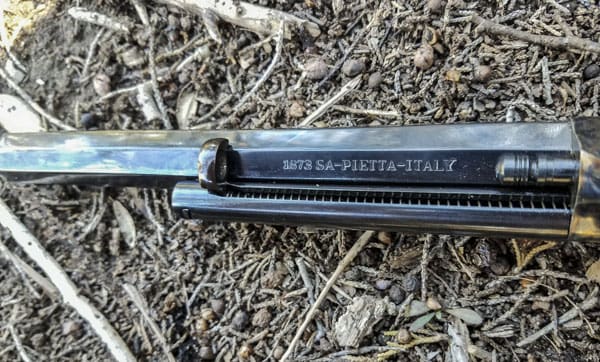
El Malo’s manufactured by Pietta of Italy, imported by Cimarron. The handgun comes in a variety of barrel lengths and calibers. The one reviewed here is the full 7 1/2” barrel chambered in .45LC, a true cowboy cartridge if there ever was one.
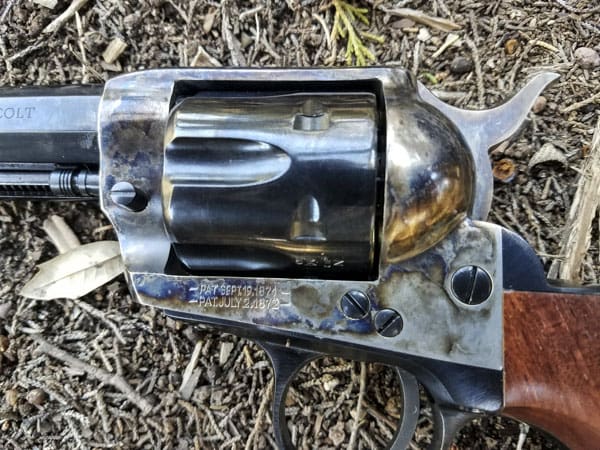
El Malo’s frame is fashioned from gorgeous color case hardened steel. The barrel’s been blued a shining black, and there’s a mirror shine throughout the metal. There’s no roughness or gross tool marks to be found. Gun companies usually skimp on the finish for their lower priced guns. That’s certainly not the case for El Malo.
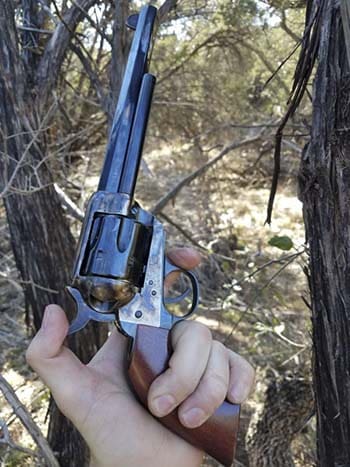
Heading out the range, I found El Malo’s smooth and simple walnut handle fit my hand well. As the day wore on the temperature hit 90 degrees (Texas “winter”). My hands got sweaty. The revolver began to slip during recoil. This isn’t a hard recoiling revolver. A classic handle shape and two and a half pounds mean the .45LC kicks like a kitten. Even so, as the handle became downright slick, I was fighting to keep a solid grip. El Malo had become El Resbaladizo (The Slippery One).
Finding ammunition for the .45LC wasn’t difficult. For the store-bought rounds, I used both Magtech’s 250gr lead flat tipped round and Winchester’s 225gr hollow points. For my hand loads, I used an almost max pressure load of eight grains of Universal pushing a 230gr LRNFP bullet.
After thoroughly cleaning the gun, I sprayed some Rogue American Apparel’s Gun Oil in the cylinders and bore and commenced to shooting. All in all, I put 250 rounds through the El Malo.
The revolver had no failures of any kind, either to cock, cycle or shoot. I noticed no change in the force it took to cycle the weapon, and it was never difficult to load or unload. The empty brass actually dropped a little easier from the cylinders at the end of the test than at the start.
When I shot the Winchester rounds, I often felt debris striking my face and shooting glasses. Nothing hard or damaging, but it was certainly there. I could find no marks, no lead around the forcing cone or top strap either. Neither my own handloads or the Magtech loads had that effect. I still haven’t figured out what was going on there.
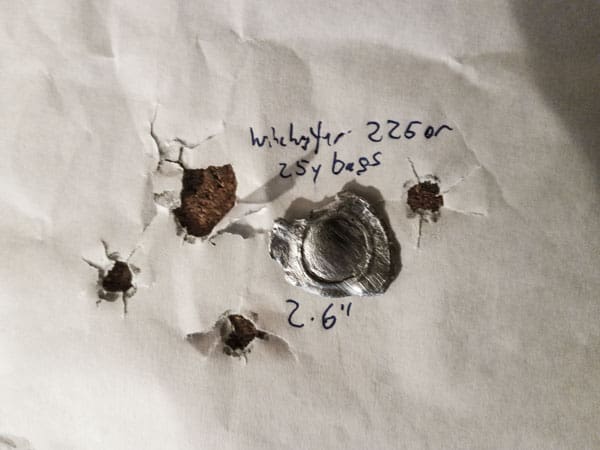
Accuracy was good but not great. The most common round I see around here in .45LC is the Winchester hollow point round, which printed a 2.6” five-shot group off of a bag at 25 yards. The Magtech scored about the same as my hand loads, averaging 2.5” but occasionally throwing a slightly smaller group.

El Malo’s sight set-up consists of a tall fixed-front iron with a notch-in-frame rear sight. Muy malo! The sights aren’t adjustable in any way, and those on mine weren’t quite right. At 25 yards, this particular revolver centered all of its groups a couple of inches to the left and about three inches high. Shooting high at that range is common on these guns, and was even considered standard, but being left of center isn’t — and there’s nothing to be done about it.
Something I certainly can’t complain about: El Malo’s trigger. It’s excellent. Breaking at a scant pound, there’s absolutely zero creep or grit. The gun is fully cocked until that little bit of pressure breaks right through the wall and the hammer fires. Considering how little pressure it takes to breach that wall, it would almost be a challenge to get the trigger pull to swing the barrel off target.
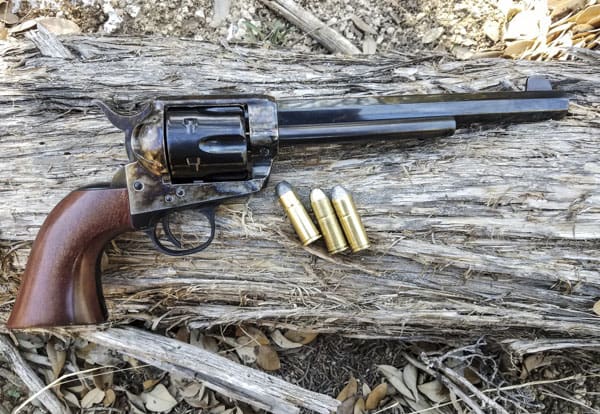
El Malo’s action is lightning quick and smooth. I cocked and turned the cylinder back-to-back between the El Malo and and my Rugers, and there’s no comparison. El Malo es muy mejor. Placing the single-action revolver on half cock and giving the cylinder a spin instantly evoked the Western movies of my youth. Or maybe a good turn on the “Wheel of Fortune.” The thing just goes and goes, turning and clicking away.
All in all, Cimarron has blessed this great nation with a great looking, good shooting Italian-made gun. El Malo will certainly turn heads at the range; it’s one of those guns that everyone wants to pick up and shoot. There’s a real working gun romance factor to it. As far as accuracy is concerned, it is what it isn’t. Note where it shoots and adjust accordingly and you can reasonably expect to put a round into a deer or pig at 25 yards. Bad guys need not apply.
Specifications: El Malo .45 Colt Single Action Pistol
Caliber: .45 LC (as reviewed)
Barrel Length: 7 1/2” (as reviewed)
Frame: Color case hardened steel
Finish: Standard blue
Grip: Walnut
Weight: 2.5 Lbs.
MSRP: $544.74
Ratings (out of five stars):
Style and Appearance * * * *
The El Malo’s color case frame and deep black/blue give the gun an authentic look, and the overall work is well executed. A point off for acceptable, but not outstanding wood.
Reliability * * * * *
If you cock the hammer and pull the trigger the gun will fire. It’s just that simple. No issues with cycling, firing, or ejecting using any of the rounds.
Accuracy * * *
Given the quality of the trigger, I was expecting better accuracy. 2 1/2” groups will still get the job done for the range or for light hunting within the range limitations of the caliber. The off-center point of aim on a fixed sight revolver was disappointing.
Overall * * *
The El Malo is a great looking gun that performs well. The trigger and action are both excellent, as is the overall fit and finish. Accuracy is OK, but nothing to write home about for a single action revolver. Printing left of the target is a big blot in an otherwise excellent copybook.

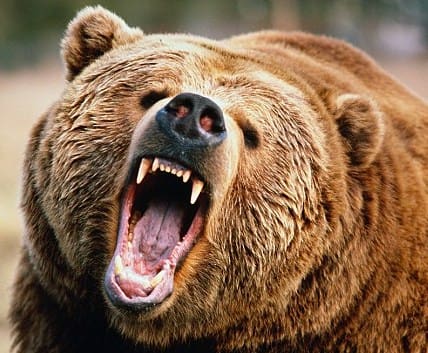

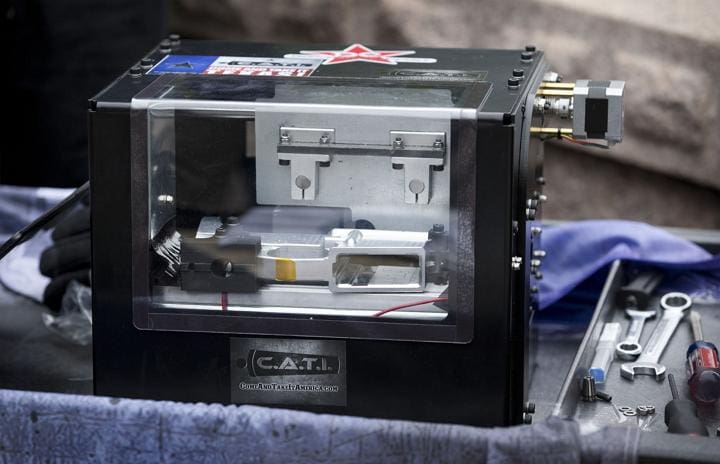
Just be sure that any .45 Colt reloads intended specifically for a Blackhawk do not ever end up in this SAA replica (or any SAA replica).
The Blackhawk revolvers are able to withstand far more pressure than the more faithful SAA clones, never mind a genuine SAA.
Wikipedia says maximum pressure for the .45 Colt is 14,000 psi. Maximum pressure for the .44 Magnum is 36,000 psi. So it would seem logical to load .45 Colt to its historically weak pressure for plinking fun, and use .44 Magnum for when you really want to open up a can of whoop-ass.
A friend of mine once made the mistake of loading .44 Magnum rounds in a .45 Colt Henry rifle. We’re all thankful the gun was built well enough for that pressure and the only damage was a few split cases.
If memory serves correctly, the Blackhawk frame was initially up sized from .357 by Bill Ruger for what would be Elmer Keith’s new 44 magnum cartridge, beating S&W’s model 29 to market by a few months. After initially being chambered for the 44, Ruger at some point chambered the larger frame in 45 colt.
Afterwards, handloaders started experimenting and were able to load 45 colt to roughly achieve 44 mag performance. Due to the larger diameter a 45 can achieve this with slightly less pressure, fortunate as cylinder wall thickness limits 45 pressure more so than 44 in the same cylinder frame.
Of mention are the likes of John Linebaugh and Dick Casull, each of which pushed the 45 colt to the very precipice of it’s limits.
John Linebaugh is now ‘smithing here in Wyoming, in the Big Horn Basin. He, more than most any other ‘smith, knows what the Ruger big-frame guns are capable of.
John’s point about the .45 Colt in modern chambers is that older guns were cut with sloppy-loose chambers, and as a result .45 Colt brass would fail from being allowed to expand too far. Modern chambers, cut to tight dimensions, can make the .45 Colt achieve so much more than people think it capable of.
“John Linebaugh is now ‘smithing here in Wyoming, in the Big Horn Basin. He, more than most any other ‘smith, knows what the Ruger big-frame guns are capable of.”
Recently read an article on him and recall it being mentioned that he had taken up residence in Wyoming. The man indeed seems to be a genius where revolver cartridges are concerned. Not merely just with his proprietary calibers, but also as mentioned the .45 Colt in his custom Rugers.
“John’s point about the .45 Colt in modern chambers is that older guns were cut with sloppy-loose chambers, and as a result .45 Colt brass would fail from being allowed to expand too far. Modern chambers, cut to tight dimensions, can make the .45 Colt achieve so much more than people think it capable of.”
Thank you for that bit of info, somewhat recall reading about Linebaugh being very meticulous when it came to his cylinder chambers. That little detail along with the beefed up, five shot cylinders must be what allows his guns to handle .45 Colt loads at near .454 Casull pressure levels. Can’t say that this one would be very eager to shoot such a load, though. .45 Colt +P in a 5.5″ Blackhawk already skins a hand adequately enough.
I would not exceed 30K PSI in a modern Ruger Blackhawk-frame revolver.
Even in Ruger’s New Model Super Blackhawk revolvers chambered for .44 Magnum?
Pretty sure he’s referring only to .45 Colt, since standard .44 mag pressure is 20% higher. Thinner cylinder walls and I believe thinner cases make .45 Colt a totally different animal.
I was referring to only the .45 Colt version of the Blackhawks.
Nice write-up. I have been interested in picking up a nice cowboy SA for a while, but it seems hard to find one that is in that sweet spot, price-wise. They’re either .22 LR’s or way out of my budget. This could be one though, hopefully the issue with the sights isn’t epidemic.
“The sights aren’t adjustable in any way…”
It’s called a file.
waiting for the video of you using a file to add metal to the front sight to bring those groups down.
You take that file to the *rear* sight to bring those groups down… 🙂
One can use lighter bullets also, to bring groups down. Heavier bullets tend to shoot higher than lighter bullets, at least in pistols. If a handloader, one can usually get a fixed sight firearm on target, at least if it isn’t a ‘freedom’ group marlin or remington with the barrel or sights put on crooked by the factory.
OFC filing works also, and is sometimes the only resort when a certain load is desired and just won’t shoot to point of aim.
I should add, although I’ve never personally done it, one can also fix windage by turning the barrel. As the two I had weren’t that far off, the file was the easiest option.
Exactly!
When you find your pet load, you file teeny bits off the rear sight to get it to shoot where you want.
I’ve done it with both a .38 special and a .22lr revolver. I locked them down in a rest, then filed a tiny bit at a time off the rear to compensate for windage and elevation, then used a bluing touch-up pen to cover over the raw metal.
On a gun like this, I’d be tempted to just have a ‘smith fit a fully adjustable ‘target’ sight to the rear and leave the front post alone…
Scraping a file across a color-case-hardened gun should be at least a class B misdemeanor.
Scraping a file across a color case hardened piece of steel will ruin both the workpiece (or the intended workpiece) and the file.
Color casing isn’t just pretty. It’s also very, very hard steel. The carbon from the charcoal pack involved in the case hardening process infuses extra carbon into the otherwise low-carbon steel. When the crucible is dumped into the frothy water quench tub, the workpiece’s outer (“case”) layer is now going to be high-carbon hard – Rc over 52, as an example.
This will dull or break the teeth off most hand files.
Don’t be silly. You have to use an elif to add metal.
I believe you can heat the front blade with a torch and bend it to correct windage. A file would be more useful to lower the point of impact.
I love the bluing on that revolver. Maybe someday I’ll have the disposable income to buy guns just ‘cuz they’re pretty. Those Italians sure do know how to make some pretty guns.
These guns can be found for very reasonable prices on the internet. My Pietta .45LC with a 4 3/4 in barrel was purchased for under $400. Also, Uberti makes a matte finished frame and cylinder (no, it’s not pretty) that has an MSRP at least $100 less than the MSRP of the shiny ones. I’ve seen them on sale for $350 (bt was not tempted because I like the shiny ones).
I have to have me a Cimmaron, maybe Xmas. Just an hour to Fredricksburg. I think I’m going for about the same finish combo, but I’m imagining a cap-and-ball with something like a 4 1/2-5″ barrel. John Wayne style. Hey, JWT, aren’t you required to have something like that? The things are beautiful, I’ll confess I’ll probably shoot it a couple dozen times, clean it up and put it away. Somehow I had missed the light trigger, but it doesn’t break my heart.
Don’t be too sure about putting that cap and ball away after a few shots. There is something just habit forming about black powder. I don’t know if it’s the smells, the ritualness of it, or just what, but it is a new(or maybe the word is, old) feeling.
Its just fun. More so, I think, than modern arms. Not that they will replace modern guns, the reliability factor just isn’t there. but they sure are fun. Enough to make up for the hot water cleaning routine, which is kind of a pain.
It could be worse, muzzle loading rifles are too big for the sink! Can’t soak it, so now what? Now its something like windex in a douche bottle, or the bathtub…
kenneth,
I have a breechloading muzzleloader. Cleaning it is amazingly easy with this process:
(1) Fill a tea kettle with clean water and start heating it.
(2) Remove breech plug from barrel.
(3) Remove barrel from stock/receiver.
(4) Hold barrel with teflon tongs and pour some boiling water down barrel.
(5) Run hot wet patches through the barrel.
(6) Pour remaining boiling water through the barrel.
(7) Put Bore Butter on a patch and run it inside your HOT barrel.
(8) Apply Bore Butter outside your HOT barrel.
Caution: make sure that your feet are clear of the BOILING water that runs through the barrel!
Removing my muzzleloader’s barrel from the receiver is a cinch. I remove one screw from the fore-end of the stock and the barrel lifts away from the receiver and stock. Piece of cake.
For the cartridge pistols, the Colt standard lengths (followed by the Italians) are 4 3/4, 5 1/2, and 7 1/2. Uberti makes one with a 3″ barrel for a horseback shooting competition. And EMF sells a “Buntline” model with a 12″ barrel (as used by Hugh O’Brian from the “Wyatt Earp” TV show). The black powders come in a variety of lengths, starting at 4″ (rare), but the standard lengths were 7 1/2 for all the full size .36 cal.s and 8″ for the 860 Colt Army. The 1848 Pocket pistol came in 4″ or 5″ barrels.
The Swedish subtitles were lulz worthy, skott instead of skjut. Bara skjut mig.
The late, great, Bob Munden. Now you’re right up my alley…
https://www.youtube.com/watch?v=_GflTkHaigo
Note that the shots at 8:25 were two shots, on two separate targets, out of the leather, in under a tenth of a second, and recorded on high speed camera.
This is well beyond even Miculek’s speed, even for split times. He calls a tenth an excellent split time, but that is for only ONE shot, not two, and not including the draw.
Not to take anything away from Miculek, it is more the design of the firearm, combined with skill, that makes these two shots happen so quickly.
Naturally, when reloading is factored in, Miculek will catch up quickly. But nothing beats a SAA for the first shot(or even two or three) at speed. Then, higher capacity firearms with quicker loading take over, but not for the first shots. Those belong to the single action only design.
One of the indoor ranges here in TN is dedicated to him. They play his videos in the waiting room. He’s pretty emtertaining to watch.
Bob Munden was also an accomplished smith, and his competition guns were very slicked up. He massaged many guns for competitors and others over the years, and I understand that his son took over the business when he died. The most basic things that are done, besides fine polishing of all moving parts, was to replace the hammer with one with a lower spur, and to lighten the hammer spring so as to make it easy to recock, yet strong enough to prevent light strikes.
If two calibers, ,357 and .45 Colt, equals a “variety of calibers” then I guess it comes in a “variety of calibers”. It’s too bad it isn’t available in .44-40 also. I scanned through some reviews and they were all as favorable as this one.
No .44-40s that I know of (except antiques) but I am pretty sure you can find .44 mag.
Guys like Munden and Miculek are irrefutable proof aliens walk amongst us…
While I fully support the unwashed gun masses experience the thrill and nostalgia of shooting these replicas, I cannot get behind this specific model with the octagonal barrel. To my eyes, its just wrong. Of course, if it gets another shooter into this type of firearm, so be it.
Of course, if you want sexy, you should find an 1872 OpenTop with Army grips preferably in 44 Colt. The ’73 just looks pedestrian compared to the ’72.
https://erikgveld.files.wordpress.com/2014/11/colt-1872-open-top.jpg
I agree with you about the octagonal barrels. There never was any such creature. I am also a purist on the black powder guns. For example, there never was a .44 cal 1851 Colt, nor and 1860 with a brass frame.
If you mean the 1851 Navy Revolver, then no, they were all.36’s, though a few were converted to .38. But the Colt Second Model Dragoon, produced in 1850 and 1851, was .44 caliber and the Colt Third Model Dragoon, produced in 1851 through 1860, was also .44 caliber.
I know the new accepted nomenclature is “45 Colt”, but “45 LONG Colt” sounds so much better!
Well, the “Long Colt” nomenclature started with the .38 Long Colt in 1875 or so, which was the official designation by Colt.
The .45 Colt then became subject to an unofficial designation of “Long Colt,” because there were other .45 cartridges in the day and the Colt was a longer cartridge overall.
Then the .45 ACP came out, and was sometimes popularly referred to (incorrectly) as “.45 Colt.” So the Long Colt appellation sort of hung on to distinguish the .45 Colt from the .45 ACP.
I have two Pietta 1873s, one in .38/.357 with a 7.5″ barrel, and one in .45 Colt with a 4 3/4 barrel. The .357 shoots low left, the .45 is dead on. But this is not specific to the Italians, as I’ve read about similar problems with the Ruger, problems that a good “western” smith can correct. I prefer the Piettas to the Ubertis because the case coloring is much brighter. The Piettas also now all come with a transfer bar safety, which some like and some do not, which in my guns needed some polishing to eliminate a fine grating sound. The nice thing about the Piettas is that they have also adopted a hand spring system I believe was pioneered by Ruger, in which there is a spring and pin held down by the top part of the grip that pushes the hand out horizontally, and which is far more reliable than the Colt spring which is thin, and fragile, sheet spring attached to the base of the hand.
I’ve also polished and tuned the internals, as I have with my other clone revolvers. I’ve found that many of these guns have a drag line on the cylinder cased by an improper locking bar tuning, and that the locking bar is often too large for the locks on the cylinder and need to be thinned. Once done, the problems go away and lock up is tight.
One other fun thing is that these cartridge revolvers can be loaded (or reloaded) with black powder instead of smokeless, and with lubed lead rounds. The standard load for cowboy action shooting is around 30 grains by volume, but the standard loading for the Army in the 1870s was 35. The case capacity is 40 if you want some kick without pressure issues. A true western experience!
So why does a gun with a 7.5″ barrel shoot such big groups? Is it just a bit of cylinder slop? Barrel/rifling tolerances?
Comments are closed.